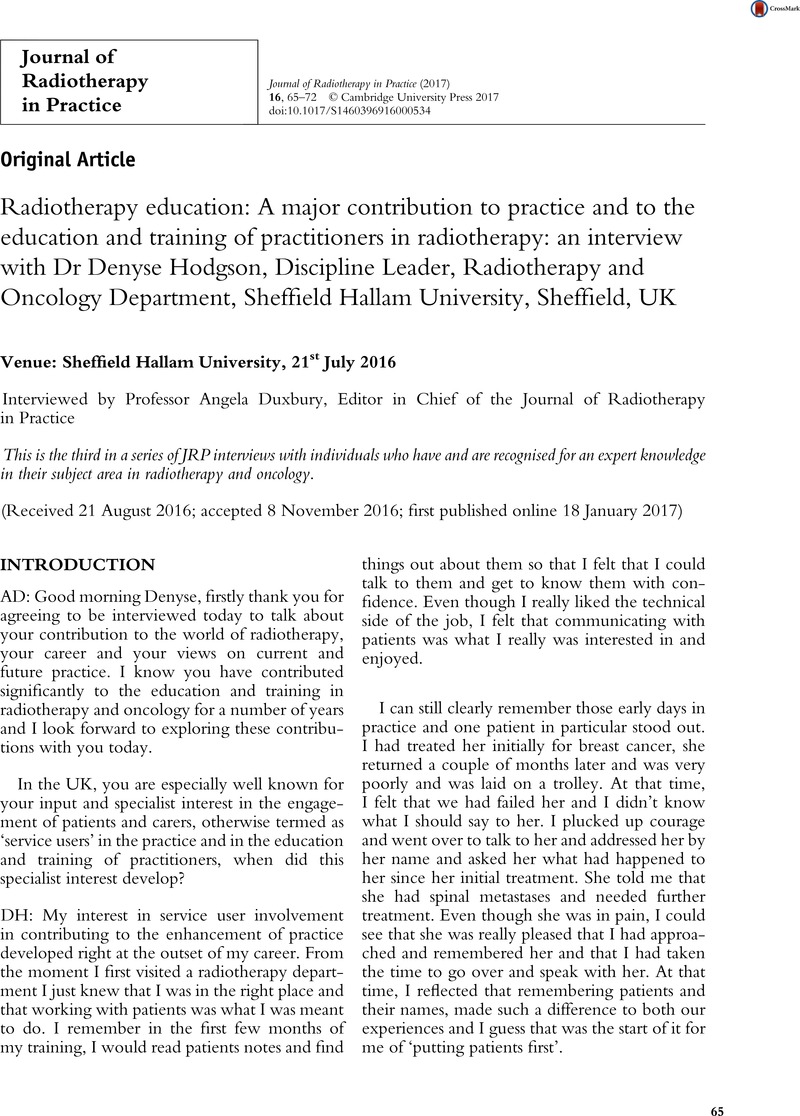No CrossRef data available.
Article contents
Radiotherapy education: A major contribution to practice and to the education and training of practitioners in radiotherapy: an interview with Dr Denyse Hodgson, Discipline Leader, Radiotherapy and Oncology Department, Sheffield Hallam University, Sheffield, UK
Published online by Cambridge University Press: 18 January 2017
Abstract
An abstract is not available for this content so a preview has been provided. Please use the Get access link above for information on how to access this content.

- Type
- Original Articles
- Information
- Copyright
- © Cambridge University Press 2017
References
1.
Calman, R, Hine, D. Calman-Hine Report A Framework for Commissioning Cancer Services. London: Department of Health, 1995.Google Scholar
2.
Husband, G, Banks Howe, G, Boal, E, Hodgson, D. A competency-based tool for education. European Journal of Cancer Care
2000; 9: 36–40.Google Scholar
3.
Beardmore, C, Colyer, H, Duxbury, A
et al. A Strategy for Educational and Professional Development of Therapeutic Radiographers College of Radiographers. London, UK: College of Radiographers, 2000.Google Scholar
4.
The Health and Care Professions Council. Standards of Proficiency for Radiographers. London, UK: Health and Care Professions Council HCPC, 2013.Google Scholar
5.
Hodgson, D. Patient and carer involvement in the radiotherapy curriculum: the impact on students’ professional development. Journal of Medical Imaging and Radiation Science
2014; 45 (4): 382–389.Google Scholar
6.
Salovey, P, Mayer, J D. Emotional Development and Emotional Intelligence: Educational Implications, Chapter 1. New York: Basic Books, 1997.Google Scholar
8.
Freshwater, D, Stickley, T. The heart of the art: emotional intelligence in nurse education. Nursing Inquiry
2004; 11 (2): 91–98.Google Scholar
9.
Macmillan Cancer Support. Living With and Beyond Cancer: Taking Action to Improve Outcomes. England: Williams Lea for the Department of Health, 2013.Google Scholar
10.
Department of Health. Delivering High Quality, Effective, Compassionate Care: Developing the Right People with the Right Skills and the Right Values. England: Williams Lea for the Department of Health, 2013.Google Scholar
11.
Thorne, S E, Kuo, M, Armstrong, E, McPherson, G, Harris, S R, Hislop, G. Being known: patients’ perspectives of the dynamics of human connection in cancer care. Psycho-Oncology
2005; 14: 887–898.Google Scholar
12.
Turnbull, P, Weeley, F M. Service user involvement: inspiring student nurses to make a difference to patient care. Nurse Education in Practice
2013; 13: 454–458.Google Scholar
13.
Francis, R. Report of the Mid Staffordshire NHS Foundation Trust Public Inquiry HC 947. London, UK: The Stationery Office (TSO), 2013.Google Scholar





